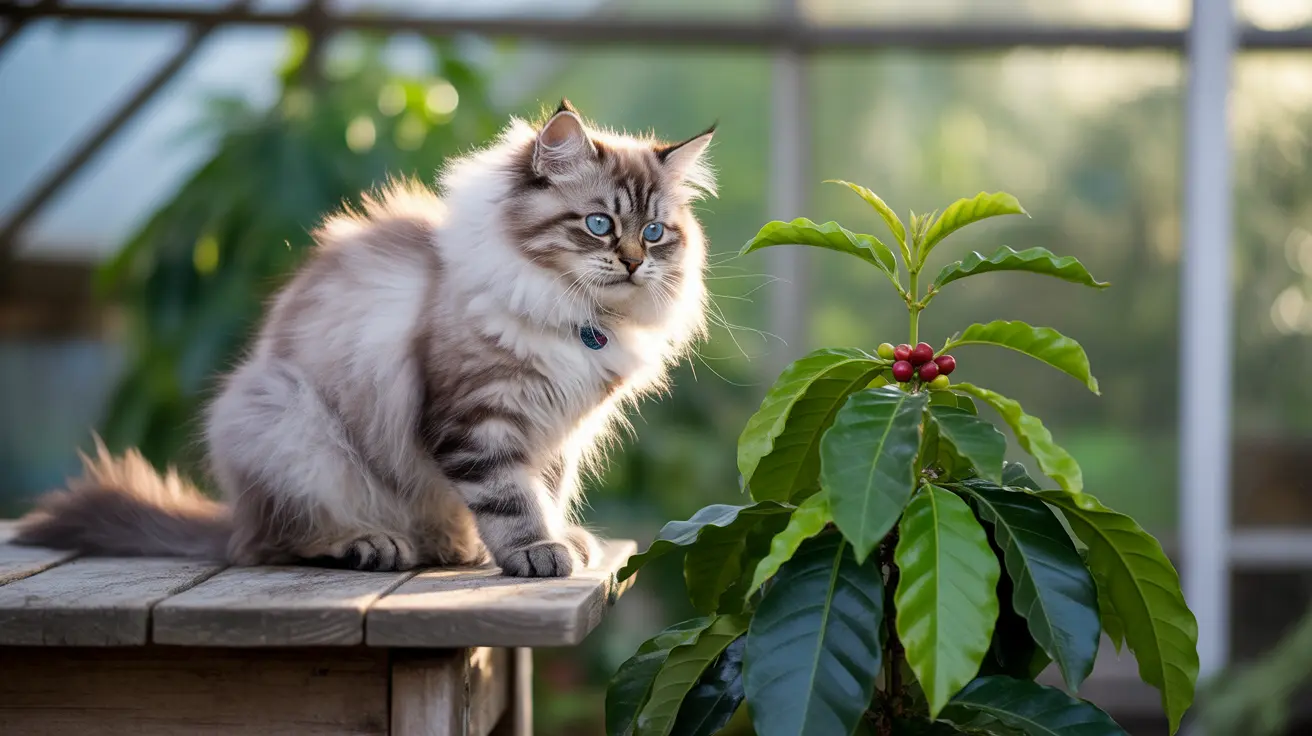Understanding Coffee Plant Toxicity
Coffee plants contain multiple toxic compounds that affect cats differently than humans. The two main types of coffee plants pose distinct risks:
Traditional Coffee Plants (Coffea Species)
These plants contain high levels of caffeine and theobromine in their leaves, berries, and beans. Cats are particularly sensitive to caffeine, with as little as 80mg per kilogram of body weight being potentially fatal. For perspective, a single coffee bean contains enough caffeine to cause concerning symptoms in a small cat.
Ornamental Coffee Trees
The Polyscias guilfoylei, commonly known as the coffee tree, contains toxic saponins throughout all plant parts. These compounds can cause both contact dermatitis and internal poisoning when ingested.
Recognizing Symptoms of Coffee Plant Poisoning
If your cat has been exposed to a coffee plant, watch for these warning signs:
- Immediate symptoms:
- Vomiting and diarrhea
- Skin irritation or rash
- Restlessness and hyperactivity
- Elevated heart rate
- Severe symptoms:
- Tremors or seizures
- Cardiac arrhythmia
- Difficulty breathing
- Collapse
Emergency Response and Treatment
If you suspect your cat has contacted or ingested any part of a coffee plant, immediate action is crucial:
- Remove your cat from the plant's vicinity
- Check for any plant material in their mouth
- Contact your veterinarian immediately
- Take photos or samples of the plant for identification
- Monitor your cat's symptoms while seeking care
Prevention and Safe Alternatives
The best approach to coffee plant toxicity is prevention:
- Keep all coffee plants out of your home if you have cats
- Consider pet-safe alternatives like spider plants or Boston ferns
- Create designated plant areas that cats cannot access
- Use deterrent sprays around any outdoor coffee plants
- Educate family members about the risks
Frequently Asked Questions
Are coffee plants toxic to cats, and which parts of the plant are most dangerous?
Yes, coffee plants are toxic to cats. All parts of both traditional coffee plants (Coffea species) and ornamental coffee trees (Polyscias guilfoylei) are dangerous, with berries and leaves being particularly hazardous due to their high concentrations of caffeine and saponins.
What symptoms should I watch for if my cat has ingested or touched a coffee plant?
Watch for vomiting, diarrhea, hyperactivity, tremors, elevated heart rate, and skin irritation. Severe cases may progress to seizures, cardiac arrhythmia, and collapse.
How quickly do caffeine and saponin toxins from coffee plants affect cats after exposure?
Symptoms can begin within 30 minutes of exposure and may last up to 12 hours. Contact dermatitis from saponins can develop within hours of touching the plant.
What should I do if my cat has chewed on coffee plant leaves or berries?
Immediately contact your veterinarian or emergency animal hospital. Take photos or samples of the plant for identification, and monitor your cat's symptoms while seeking care.
Are there safe indoor plant alternatives for homes with cats instead of coffee plants?
Yes, many pet-safe alternatives exist, including spider plants, Boston ferns, bamboo palms, and African violets. Always verify a plant's safety before bringing it into a home with cats.
Remember, when it comes to coffee plants and cats, prevention is always better than treatment. If you're unsure about a plant's safety, consult with your veterinarian or check reliable pet toxicity databases before bringing it into your home.






